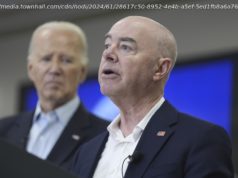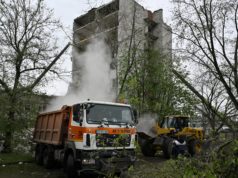9 essential things to know about Puerto Rico’s humanitarian crisis.
Early on Wednesday, September 20, Hurricane Maria, a powerful Category 4 hurricane with 150 mph winds, made direct landfall on Puerto Rico, bisecting the entire island and drenching it with feet of rain. What’s happened since has been truly catastrophic for Puerto Rico.
There’s still little power on the island. In many places there’s still no water to drink or bathe in or to flush toilets. There’s limited food and cell service, and dozens of remote villages have been completely cut off from everything for weeks.
“Make no mistake — this is a humanitarian disaster involving 3.4 million US citizens,” Puerto Rico Gov. Ricardo Rosselló said the Monday after Maria hit.
The initial recovery response from the US federal government has been lackluster, and President Trump’s comments have not inspired confidence. After dwelling early in the week on the facts that 1) Puerto Rico is an island, and 2) Puerto Rico is in massive debt, the president and his senior officials then went on the defensive, describing the administration’s response so far as a “good news story.”
“Help us. Without robust and consistent help we will die,” Carmen Yulín Cruz Soto, the mayor of San Juan, Puerto Rico, said in a statement October 12. “Mr. President, fulfill your moral imperative towards the people of Puerto Rico.”
This is still a terrible disaster that deserves more coverage and a better coordinated response — and both appear to have been impeded by widespread confusion about Puerto Rico’s relationship to the United States and the severity of its current situation. Here’s what every American needs to know.
According to a new Morning Consult poll published in the New York Times, only 54 percent of Americans know that Puerto Ricans are US citizens. The poll found 81 percent of those who knew Puerto Ricans were citizens supported sending to aid to the island. Just 44 percent of those who didn’t know said the same.
Puerto Ricans have been citizens of the United States since 1917, when President Woodrow Wilson signed the Jones-Shafroth Act. Citizens mean citizens. Puerto Ricans can travel freely to and from the continental United States without a passport. They’re protected by the same Bill of Rights as anyone else born in the United States. They vote in presidential primaries.
The island does not get electoral votes in general presidential elections. It also does not have voting representatives in Congress. Jenniffer González-Colón serves as resident commissioner of Puerto Rico, a nonvoting member of the US House of Representatives.
If Puerto Rico were a state, it would be the 30th most populated — with more people than Wyoming, Vermont, and Alaska combined.
Under the Stafford Act, which governs federal response to major disasters, the federal government must treat Puerto Rico like a state.
“[Puerto Ricans] are entitled to the same response from the federal government as the citizens of New York or Kansas would be if they were visited by a natural disaster on the scale of Hurricane Maria,” the editors of America magazine, a Catholic publication, wrote on September 25. “Although the United States has long benefited from the geographical reach they provide … [island territories] have been taken for granted and denied full political representation. Hurricane Maria is a reminder that this two-tiered system of American citizenship is neither democratic nor tenable.”
This hurricane season has been punishing for Puerto Rico. First, it got clipped by Hurricane Irma, a huge Category 5 storm whose eye passed just north of the island. That storm — which had ravaged several Caribbean islands — left 1 million people without power on Puerto Rico. By the time Maria hit, 60,000 people were still without electricity. That means there are many people on the island who haven’t had power for over a month. (Irma passed by on September 7.)
Maria was a slightly smaller storm, but it was far, far more devastating. That’s because it charted a course directly over Puerto Rico, hit near its peak intensity, and passed around 25 miles away from San Juan, the capital, which is home to about 400,000 people. No nation or territory could suffer such a direct hit without some damage.
“It was as if a 50- to 60-mile-wide tornado raged across Puerto Rico, like a buzz saw,” Jeff Weber, a meteorologist with the National Center for Atmospheric Research, says. “It’s almost as strong as a hurricane can get in a direct hit.”
By the record books, it was the fifth-strongest storm ever to hit the US, and the strongest storm to hit the island in 80 years. “The devastation is vast,” Gov. Rosselló said in a statement. “Our infrastructure and energy distribution systems suffered great damages.”
Exact figures on the extent of the damage and the costs of repairs on the island are not yet known. This is partly due to the fact that communications on the island are strained. But it’s also because many roads are damaged and it’s hard to get around. Moody’s Analytics, a financial services firms, estimates the storm could cost Puerto Rico $45 billion to $90 billion.
Photos show whole communities with roofs torn off, second floors of houses ripped apart, water flooding the streets, and people resorting to waiting in long lines for clean water and fuel. In reports, the word “apocalyptic” is used often.
More concretely, we do know that Puerto Rico’s infrastructure is severely crippled. These are major problems that will make living even in an intact house more difficult in the coming weeks and months.
Power is out across the island — and Puerto Rico’s energy system was troubled to begin with
The storm knocked out 80 percent of the island’s power transmission lines, the Associated Press reports. And as of October 16, some 86 percent of the island’s 1.57 million electricity customers were still without power. Many people have generators, and new ones are being distributed. According to Army Lt. Gen. Jeffrey S. Buchanan, the commander of ground forces on the island, the fuel situation had largely returned to normal by October 16, though 20 percent of gas stations are still closed.
In the photos below, NOAA compares what the lights of Puerto Rico looked like from space on a calm night in July, and then compare it to what the island looked like post–Hurricane Maria. The faint lights that remain are powered by gas generators.
It could be four to six months before power is fully restored on the island, though the government has set a goal of restoring 95 percent by December. That’s months with Puerto Rico’s 3.4 million residents relying on generators, months without air conditioning in the tropical climate, months that electric pumps can’t bring running water into homes, months with even the most basic tasks of modern life made difficult.
PREPA, the electric company on the island, has a massive $9 billion debt, as Vox’s Alexia Fernández Campbell has explained, and in July it defaulted on an interest payment. For years, it hasn’t had the money to invest in modernizing Puerto Rico’s electrical systems. Even without hurricanes, power outages are frequent on the island. Making things worse: There aren’t enough workers to fix the infrastructure. Young people have been leaving the island in droves as the economy has tightened, and older workers have been retiring en masse, securing their pensions.
Rebuilding the system on the island will be a long and difficult process. Getting the power back on in Puerto Rico “will be daunting and expensive,” the New York Times explains. “Transformers, poles and power lines snake from coastal areas across hard-to-access mountains. In some cases, the poles have to be maneuvered in place with helicopters.”
Fresh water is scarce
No electricity means no power to pump water into homes, no water to bathe or flush toilets. As of October 16, the government said municipal water services had been restored for 72 percent of people on the island. But there are still significant health concerns about the water shortages on the island — among them that people are drinking from contaminated streams and other sources. Rescue workers have been distributing bottled water, but in some places, there isn’t enough to go around.
The Guardian reported on October 11 that FEMA officials were concerned about a huge food shortage on the island. FEMA says the government is providing 200,000 meals a day, but there was a shortfall of 2 million meals a day.
Cellphone towers are knocked out
The storm knocked out 1,360 out of 1,600 cellphone towers on the island, but only 43 percent have been fixed. Many communities have been isolated from the outside world for nearly 4 weeks, relying only on radios for news. National Guard members told the Daily Beast they were struggling to communicate on the ground, making their ability to respond to the disaster exceptionally hard. “There’s no communication, that’s the problem,” said Capt. Jeff Rutkowski.
Most hospitals are running on generators with limited fuel
In its latest report, FEMA says 64 out of 67 hospitals are open.
Most are running on generators, and there are issues with distributing fuel. So there’s still limited access to X-ray machines and other diagnostic and life-saving equipment.
Initially, power was knocked out at almost all the island’s hospitals, leading to life-threatening emergencies. “Two people died yesterday because there was no diesel in the place where they were … In San Juan, a hospital,” Mayor Yulín Cruz told CBS News in an emotional interview September 26. “We need to get our shit together.”
And the health crisis on the island could grow if power is not soon restored, as Vox’s Julia Belluz reports .
“Just about every interaction with the health system now involves electricity, from calling a hospital for help to accessing electronic medical records and powering lifesaving equipment like hemodialysis machines or ventilators,” Belluz writes.
As of October 12,4 people had died and 10 were sickened with leptospirosis, a bacterial illness spreading in the aftermath of the storm through contact with contaminated animal urine either directly or via water or soil.
Farms are decimated
Agriculture is a small part of the Puerto Rican economy, contributing just 0.8 percent to its GDP and employing 1.6 percent of its labor force. But it was decimated — in a nearly literal sense of the word — by Hurricane Maria.
“In a matter of hours, Hurricane Maria wiped out about 80 percent of the crop value in Puerto Rico,” the New York Times reports. That amounts to a $780 million loss. The island imports 85 percent of its food, but the destruction of its agricultural sector is likely to increase prices and exacerbate the scary prospect of continued food shortages on the island.
Weather radar is down, making it harder to forecast new storms
On September 24, the National Weather Service reported that its Doppler radar station on the island had been destroyed.
Home
United States
USA — Events What every American needs to know about Puerto Rico’s hurricane disaster






